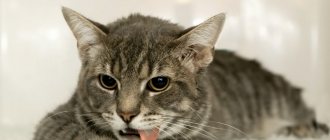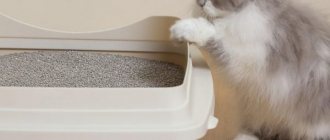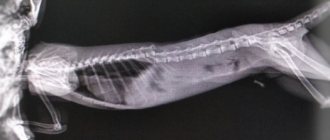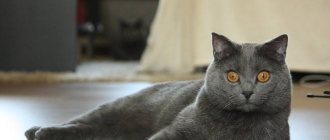- Changes that occur during cardiac dysfunction, their causes.
- What does heart failure look like in cats?
- Diagnosis of insufficient functioning of the cardiovascular system.
- How can I help my cat?
In heart failure, disturbances in the “pumping” function of the heart are observed, when the blood supply to the whole organism deteriorates significantly. That is, tissues and organs do not receive oxygen and other nutrients. Moreover, the higher the activity of the animal, the stronger this shortage appears. The pathology is quite uncommon in cats, but this does not mean that it does not deserve due attention.
Do cats have heart attacks? The answer is yes!
Heart attack is not a veterinary term, but a complaint from pet owners!
A heart attack in cats is a manifestation of heart failure syndrome. This problem is associated with genetically determined heart disease in cats. Heart disease occurs in all breeds of cats, but most often in representatives of risk group breeds (British, Scottish, Sphynx, Persian, Maine Coon).
The article discusses the main causes, symptoms, treatment and first aid for a heart attack in cats. What are the main symptoms, causes, treatment and first aid for a heart attack in cats?
Diseases of the heart muscle in cats are hidden for a long time, but appear suddenly after stress, especially after castration and sterilization of apparently healthy animals. Therefore, it is recommended that cats be screened by a cardiologist before undergoing planned interventions.
Major heart diseases
Depending on the area of damage, the following diseases are distinguished:
- Pathologies of the heart muscle (myocardium).
- Problems with the heart valve (defect).
- Arrhythmia is an abnormal heart rhythm.
- Endocarditis is inflammation of the endocardium, the inner lining of the heart muscle. The cause of the disease is a bacterial infection that damages myocardial tissue, causing erosions. Complications – valve deformation, heart failure, abscess of internal organs.
- Pericarditis is an inflammation of the serous membrane of the myocardium, when the volume of fluid increases in it, complicating the work of the myocardium. The pathology occurs in cats, middle-aged and elderly dogs. Causes include infection, acute allergies, penetrating chest injuries, sepsis, and tumors.
Constriction of blood vessels leads to increased blood pressure. This increases the load on the heart, which, when pumping, is forced to exert greater force so that the blood can reach all parts of the body. The result is premature wear of the myocardium.
A separate group can be divided into a heart attack, the causes of which are stenosis (persistent narrowing of veins and arteries) or blockage of a coronary vessel by a thrombus. If it is partially blocked, blood can flow, the animal will survive, although it will suffer. If the blockage is complete, the pet will most likely die.
Causes of heart attack in cats
Cause of heart attack
- genetic changes in the structure and function of the myocardium, that is, various gene mutations. Most pathological genes for damage to heart cells in cats are in a “dormant” state, can be activated during the growth of animals, or can remain in a “dormant” state until the end of the animal’s life.
Cardiomyopathies are the immediate cause of heart attacks in cats.
The following cardiomyopathies are known in cats:
- Hypertrophic - hypertrophy of the walls of the left and sometimes right ventricle.
- Restrictive - fibrous degeneration of the myocardium, thickening of the heart muscle, with normal thickness of the walls of the heart.
- Right ventricular dysplasia of the right ventricle is a fibrofatty degeneration of the wall of the right ventricle.
- Dilated - a sharp decrease in the contractility of the left ventricular myocardium and expansion of its cavity with normal or reduced wall thickness.
- Stress-induced - reversible cardiopathy, which occurs after stress factors, is manifested by temporary thickening of the walls of the heart. This pathology is completely cured within 1-2 months if the symptoms of congestive heart failure are controlled.
- Secondary cardiomyopathies (for diseases of other internal organs)
- Unclassified cardiomyopathies (transitional forms, unstudied pathologies)
What is sudden death?
The name speaks for itself: this is the sudden death of an animal (be it a dog, a cat...). In the case of cats, his own survival instinct has developed so much that he knows well how to hide pain; in fact, he will only show signs of weakness if he is very confident in his person and if he also lives in a quiet and pleasant environment.
Therefore, it is very important to pay attention to the cats that we have at home, since any symptoms, any small changes in your daily routine could be a sign of illness.
© shutterstock
What are the symptoms of a heart attack in a cat?
- Increased breathing rate during sleep
- Increased breathing rate at rest
- Hard breath
- Decreased appetite
- Pale and cyanotic tongue
- Forced pose
- Excitation
- Decreased body temperature
- Weakness - exercise increases symptoms
Increased breathing rate during sleep and at rest.
Cats with a heart attack pant rapidly. Breathing is difficult, abdominal, sometimes with wheezing. The cat is trying to inhale with greater amplitude. The intercostal spaces and hypochondrium may sink during maximum inspiration. The most valuable symptom in sick cats is an increase in breathing rate during sleep more than 27 times per minute. This means that the animal may have pulmonary edema or fluid accumulation in the chest cavity and require emergency hospitalization.
A less accurate symptom of heart attack in a cat is an increase in resting respiratory rate of more than 30 times per minute.
Stress can affect the breathing rate of a healthy cat. However, if your cat has increased breathing at rest, you should also seek help from a veterinary clinic. Cats with a heart attack may scream and worry, move around and cannot find a place for themselves or a comfortable position.
Hearing loss in a cat due to a heart attack is not a typical symptom. Hearing loss is possible in severe heart failure, when there is insufficient oxygen supply to the brain. Cats very often die from a heart attack.
First aid for a cat at home
Let’s immediately decide on one point: if the pet is already lying down with an attack, then the only effective first aid is to immediately call a veterinarian.
It is hardly possible to do anything else at home (in particular, pouring medicine into the mouth is no longer useful). Therefore, it is necessary to “catch” the first warning signs of an attack, since at this time it is still possible to at least somehow help the animal:
- 3 drops of cardamine. Also, some veterinarians advise giving the cat up to 11 drops of Corvalol. If everything is done on time, then the attack will almost certainly be extinguished or, at least, significantly alleviated.
- The cat is shown absolute peace. If an animal feels bad, there is no need to run around it, put it in a basket and go to the clinic. This can only worsen the pet’s condition, speed up and worsen the attack of acute heart failure in the cat.
- The cat must be placed in a cool, well-ventilated room. The hotter and stuffier the room, the more severe the heart attack. A fact known to many doctors. Of course, this does not mean that the cat should be thrown out onto the balcony or placed directly under the air conditioner, but it is worth opening the window slightly or turning on the fan.
First aid for a cat having a heart attack
- It is necessary to take your pet to a veterinary clinic as quickly as possible.
If an animal has a previously diagnosed heart disease and a sudden attack occurs, then you need to inject the cat intramuscularly with 0.5-1.0 ml of furosemide (Lasix) and urgently take the animal to the clinic. - During a heart attack, a cat should not be forcibly placed on its side.
It is advisable to raise the upper part of the animal’s body (so that the head is higher than the limbs).
At the clinic, doctors will use intravenous injections of furosemide. Provide oxygen to the animal's breathing. If necessary, the patient will be given sedatives. It is possible that drugs such as nitroglycerin, dobutamine, and vetmedin will be used.
Diagnosis of heart failure
Do not treat yourself. You don't joke with your heart; wrong actions will lead to the death of your pet. Before starting therapy, the doctor must listen to the dog and prescribe:
- Ultrasound of the heart (ECHO) - shows the condition of the valves, deviations in the functioning of the heart muscle, underdevelopment of the left ventricle, the exact size and structure of the heart.
- Chest X-ray – shows infectious diseases (pneumonia), neoplasms, helps determine heart defects, pericarditis, myocardial diseases.
- Electrocardiogram (ECG) – records the heart rhythm and myocardial activity.
- Complete blood count - shows the level of red blood cells, leukocytes, platelets, deviations from the norm indicate a disease.
- Biochemical blood test - the doctor may prescribe a test for the level of AP, potassium, sodium, glucose and other substances, the indicators of which change in cardiovascular diseases. Unfortunately, not every veterinary hospital does such tests. In this case, you can contact a human laboratory and have the data deciphered taking into account the characteristics of dogs or cats.
Good to know
- Can cats hide pain?
- Serval cats
- Urinary retention in cats
- Causes of pain syndrome in cats
- Feline Orofacial Pain Syndrome
- Catnip for cats
- How to care for an old cat?
- How to properly dry a cat?
- How to Choose a Kitten for your Home
- Pneumonia of Cats
- Causes of Sneezing in Cats
- Anatomy and physiology of the liver in cats
- The structure and functions of the thyroid gland in cats
- Measuring blood pressure in cats
- Current role of dexmedetomidine in clinical veterinary and medical anesthesia and intensive care
- Thyroid function testing in cats
- Gabapentin in cats and dogs
- Information content of hematological and echocardiographic preoperative screening indicators
- Historical background on hyperthyroidism in cats
- Hyperthyroidism in older cats
- Cardiac hypertrophy in cats
- Analysis of anamnestic data during preoperative examination of animals
- Study of anamnestic data in cats before general anesthesia
- Method for measuring blood pressure in cats
- ICD in cats (diagnosis and symptoms)
- Hyperthyroidism is suspected, but serum T4 concentration is normal
- Acute gastroenterocolitis in dogs (etiology, pathogenesis, diagnosis and treatment)
- Reducing mortality during anesthesia is an important task of veterinary anesthesiology
- Thrombosis in cats (general information, etiology, pathogenesis, clinical picture, diagnosis and treatment)
- Urolithiasis of small animals (etiology, pathogenesis, diagnosis and treatment)
- Congestive cardiomyopathy in cats (What is it? How to protect your pets)
- Gastrointestinal tract in dogs (anatomy and physiology)
How long do cats live?
In cats, starting from the age of 2 weeks, a year of life lived is equal to 4 human years. By the way, in dogs this figure is 7 years. The average lifespan of cats is about 16 years (80 for humans).
The approaching old age does not go unnoticed by a caring owner, because the animal becomes much less active, and performing everyday tasks causes a burden.
Prevention measures
Experienced breeders try to observe the following preventive measures:
- The animal's diet must be balanced. For old and castrated/sterilized pets, food is selected separately.
- The cat must be regularly, promptly vaccinated and treated against parasites.
- It is necessary to lock household chemicals, medications, and other potentially toxic compounds in places inaccessible to animals.
- Contact your veterinarian promptly if you notice strange behavior or other alarming symptoms.
Is it humane to euthanize a cat?
If all the signs that are observed when death is approaching are present, then the owner must decide what to do with the cat. Artificial killing is perceived by some as betrayal and the murder of a dear friend. In this case, it is better to surround the pet with care and love, trying to provide all possible assistance.
© shutterstock
But the disease can cause unbearable pain and progress for quite a long time. Symptoms of oncology and urolithiasis are considered especially severe.
Watching the torment of a once active and cheerful pet is unbearable. Everything must be done for a dying cat to alleviate the suffering.
Sometimes euthanasia is much more humane than the unbearable suffering of an animal for several weeks. The veterinarian will inject the cat with a special drug that will ensure a quiet and painless death within a few seconds. During the procedure, you can stay next to your friend, accompanying him on his final journey, or leave the room.










